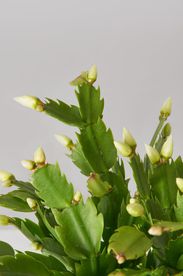You may be used to having a Christmas cactus in your home as a festive green and red, low-maintenance house plant, but did you know that there are also Thanksgiving cactus and Easter cactus varieties?
The difference between these festive cacti is so subtle that they are often sold as each other on accident. Luckily the care for each species is the same: moderate light and watering about once a week. Here’s how to tell which cactus you have and during which holiday it will bloom.
How to Identify Holiday Cacti Varieties
Thanksgiving, Christmas, and Easter cacti are part of the Schlumbergera genus that’s native to Brazilian rain forests where they grow on trees like orchids, according to the Southern Living Garden Book.
These holiday cacti blooms come in a variety of colors. Christmas cactus has purplish-red flowers; Thanksgiving cactus comes in white, pink, salmon, orange, and yellow; and Easter cactus flowers can have pink, orange, red, or white hues.
Known for their leaf-like pads, or stem segments, the real trick to telling the difference between each species is to look at the shape of the stem segments and take note of what season they’re blooming in, Erin Marino, editorial lead at The Sill, says.
How Blooming Correlates With the Holidays
Each of their common names refers to their flowering season. Thanksgiving cactus (Schlumbergera truncata) and Christmas cactus (Schlumbergera x buckleyi, sometimes labeled Schlumbergera bridgesii) varieties are the two most confused for each other because their blooming periods are back-to-back. Thanksgiving cacti typically bloom between November and December, while Christmas cacti bloom from January to February. However, houseplants can be forced to bloom at any time, and some Thanksgiving cacti will bloom closer to Christmas, Marino says. The Easter cactus (Schlumbergera gaertneri) blooms in early spring, and it has the most noticeable difference in stem segment shape of the three. They are all collectively known as holiday cacti.
Marino says that the common confusion between the Thanksgiving and Christmas cacti make blooming season a less helpful way of identifying each variation, so it’s best to look at the shape of the stem segments instead. Because the Thanksgiving cactus blooms leading up to Christmas, it is most often the one available during the holiday season.
How Stem Segments Tell the Difference
The Thanksgiving cactus has the spikiest stem segments of the three varieties, and its pollen is yellow. The Christmas cactus has less spikey pads with rounder edges, and its pollen is pink. The Easter cactus has subtle, rounded edges on its stem segments. Sometimes Easter cactus can also have small hairs on their leaves, Marino says.



How to Care for a «Holiday» Cactus
You may find that some stores label a cactus from the Schlumbergera genus as a «Holiday Cactus,» to prevent consumers from confusing the blooming periods of the plants.
According to the Missouri Botanical Garden, to encourage Thanksgiving and Christmas cacti blooms, make sure they get bright light, night temperatures between 55 F and 65 F, and long nights of around 13 hours of continuous darkness. Easter cactus also needs bright light and night temperatures of 55 F to 65 F and will bloom as the days get longer between March and May, the North Carolina State Extension website says.
For general care, aside from bright light to partial shade, water moderately. Keep soil moist—to prevent root rot, do not overwater these plants—the soil can go somewhat dry between waterings after the blooming season. If your holiday cactus needs to be repotted, use a cactus or succulent potting mix, which is much lighter than regular potting soil. This should be a pH-balanced mix that may contain 60-80% potting soil with 40-20% perlite, recommends Clemson University’s Cooperative Extension. Fertilize monthly, after their flowering season ends and when new growth starts, and then reduce when flower buds form.
How to Propagate Your Cacti
Consider propagating your holiday cacti to share with others. They are easy to grow from cuttings, making them perfect holiday and seasonal hosting gifts. Take a Y-shaped cutting with two or three joined segments from a stem tip and let the cut end dry for a few days. Place the dried segment one inch deep in potting soil, and water to keep moist. Growth should appear after three weeks. Cuttings can also be put in water and transplanted once roots begin to show and reach two inches in length.
Succulent and Cacti Tips
Whether a Thanksgiving, Christmas, or Easter cactus, with the right care, these seasonally flowering houseplants can definitely add cheer and beauty to your holiday and throughout the year. To learn more about low-maintenance houseplants, check out our cactus and succulent care guides.